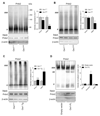Oxidation resistance 1 regulates post-translational modifications of peroxiredoxin 2 in the cerebellum
- PMID: 30389497
- PMCID: PMC6339520
- DOI: 10.1016/j.freeradbiomed.2018.10.447
Oxidation resistance 1 regulates post-translational modifications of peroxiredoxin 2 in the cerebellum
Abstract
Protein aggregation, oxidative and nitrosative stress are etiological factors common to all major neurodegenerative disorders. Therefore, identifying proteins that function at the crossroads of these essential pathways may provide novel targets for therapy. Oxidation resistance 1 (Oxr1) is a protein proven to be neuroprotective against oxidative stress, although the molecular mechanisms involved remain unclear. Here, we demonstrate that Oxr1 interacts with the multifunctional protein, peroxiredoxin 2 (Prdx2), a potent antioxidant enzyme highly expressed in the brain that can also act as a molecular chaperone. Using a combination of in vitro assays and two animal models, we discovered that expression levels of Oxr1 regulate the degree of oligomerization of Prdx2 and also its post-translational modifications (PTMs), specifically suggesting that Oxr1 acts as a functional switch between the antioxidant and chaperone functions of Prdx2. Furthermore, we showed in the Oxr1 knockout mouse that Prdx2 is aberrantly modified by overoxidation and S-nitrosylation in the cerebellum at the presymptomatic stage; this in-turn affected the oligomerization of Prdx2, potentially impeding its normal functions and contributing to the specific cerebellar neurodegeneration in this mouse model.
Keywords: Antioxidant; Chaperone; Mouse; Neurodegeneration; Oxidative stress; Peroxiredoxin.
Crown Copyright © 2018. Published by Elsevier Inc. All rights reserved.
Figures





Similar articles
-
Oxr1 is essential for protection against oxidative stress-induced neurodegeneration.PLoS Genet. 2011 Oct;7(10):e1002338. doi: 10.1371/journal.pgen.1002338. Epub 2011 Oct 20. PLoS Genet. 2011. PMID: 22028674 Free PMC article.
-
Oxidation Resistance 1 Modulates Glycolytic Pathways in the Cerebellum via an Interaction with Glucose-6-Phosphate Isomerase.Mol Neurobiol. 2019 Mar;56(3):1558-1577. doi: 10.1007/s12035-018-1174-x. Epub 2018 Jun 15. Mol Neurobiol. 2019. PMID: 29905912 Free PMC article.
-
Effects of Peroxiredoxin 2 in Neurological Disorders: A Review of its Molecular Mechanisms.Neurochem Res. 2020 Apr;45(4):720-730. doi: 10.1007/s11064-020-02971-x. Epub 2020 Jan 30. Neurochem Res. 2020. PMID: 32002772 Review.
-
S-nitrosylation of peroxiredoxin 2 exacerbates hyperuricemia-induced renal injury through regulation of mitochondrial homeostasis.Free Radic Biol Med. 2025 Mar 16;230:66-78. doi: 10.1016/j.freeradbiomed.2025.02.003. Epub 2025 Feb 6. Free Radic Biol Med. 2025. PMID: 39921115
-
Implications and progression of peroxiredoxin 2 (PRDX2) in various human diseases.Pathol Res Pract. 2024 Feb;254:155080. doi: 10.1016/j.prp.2023.155080. Epub 2024 Jan 3. Pathol Res Pract. 2024. PMID: 38219498 Review.
Cited by
-
The OxrA Protein of Aspergillus fumigatus Is Required for the Oxidative Stress Response and Fungal Pathogenesis.Appl Environ Microbiol. 2021 Oct 28;87(22):e0112021. doi: 10.1128/AEM.01120-21. Epub 2021 Sep 15. Appl Environ Microbiol. 2021. PMID: 34524893 Free PMC article.
-
Catalytic activity regulation through post-translational modification: the expanding universe of protein diversity.Adv Protein Chem Struct Biol. 2020;122:97-125. doi: 10.1016/bs.apcsb.2020.05.001. Epub 2020 Jun 27. Adv Protein Chem Struct Biol. 2020. PMID: 32951817 Free PMC article. Review.
-
Neuronal over-expression of Oxr1 is protective against ALS-associated mutant TDP-43 mislocalisation in motor neurons and neuromuscular defects in vivo.Hum Mol Genet. 2019 Nov 1;28(21):3584-3599. doi: 10.1093/hmg/ddz190. Hum Mol Genet. 2019. PMID: 31642482 Free PMC article.
-
Pathogenic mechanisms of preeclampsia with severe features implied by the plasma exosomal mirna profile.Bioengineered. 2021 Dec;12(2):9140-9149. doi: 10.1080/21655979.2021.1993717. Bioengineered. 2021. PMID: 34696680 Free PMC article.
-
Neuroinflammation and Lysosomal Abnormalities Characterise the Essential Role for Oxidation Resistance 1 in the Developing and Adult Cerebellum.Antioxidants (Basel). 2024 Jun 3;13(6):685. doi: 10.3390/antiox13060685. Antioxidants (Basel). 2024. PMID: 38929124 Free PMC article.
References
Publication types
MeSH terms
Substances
Grants and funding
LinkOut - more resources
Full Text Sources
Medical
Molecular Biology Databases
Research Materials
Miscellaneous

